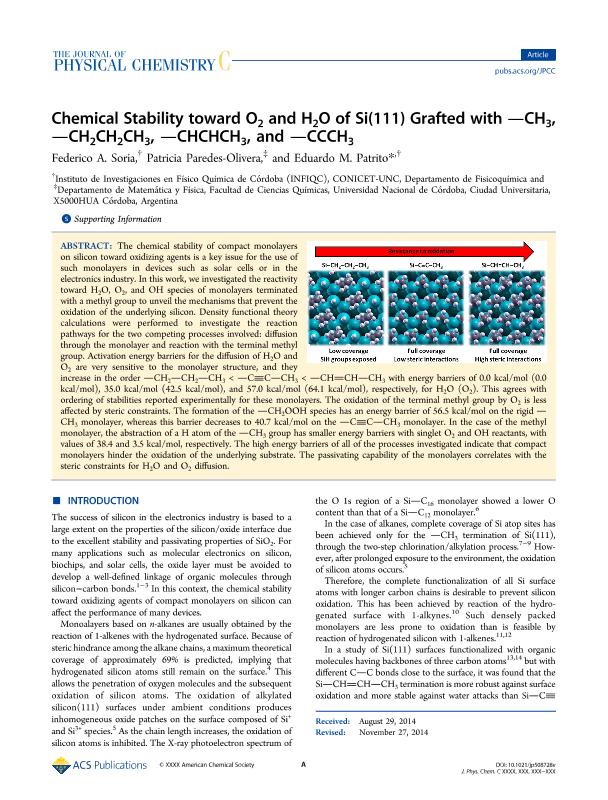Mostrar el registro sencillo del ítem
dc.contributor.author
Soria, Federico Ariel

dc.contributor.author
Paredes Olivera, Patricia

dc.contributor.author
Patrito, Eduardo Martin

dc.date.available
2017-12-22T13:32:41Z
dc.date.issued
2014-12
dc.identifier.citation
Soria, Federico Ariel; Paredes Olivera, Patricia; Patrito, Eduardo Martin; Chemical Stability toward O2 and H2O of Si(111) Grafted with —CH3, —CH2CH2CH3, —CHCHCH3, and —CCCH3; American Chemical Society; Journal of Physical Chemistry C; 119; 12-2014; 284-295
dc.identifier.issn
1932-7447
dc.identifier.uri
http://hdl.handle.net/11336/31352
dc.description.abstract
The chemical stability of compact monolayers on silicon toward oxidizing agents is a key issue for the use of such monolayers in devices such as solar cells or in the electronics industry. In this work, we investigated the reactivity toward H2O, O2, and OH species of monolayers terminated with a methyl group to unveil the mechanisms that prevent the oxidation of the underlying silicon. Density functional theory calculations were performed to investigate the reaction pathways for the two competing processes involved: diffusion through the monolayer and reaction with the terminal methyl group. Activation energy barriers for the diffusion of H2O and O2 are very sensitive to the monolayer structure, and they increase in the order —CH2—CH2—CH3 < —C≡C—CH3 < —CH═CH—CH3 with energy barriers of 0.0 kcal/mol (0.0 kcal/mol), 35.0 kcal/mol (42.5 kcal/mol), and 57.0 kcal/mol (64.1 kcal/mol), respectively, for H2O (O2). This agrees with ordering of stabilities reported experimentally for these monolayers. The oxidation of the terminal methyl group by O2 is less affected by steric constraints. The formation of the —CH2OOH species has an energy barrier of 56.5 kcal/mol on the rigid —CH3 monolayer, whereas this barrier decreases to 40.7 kcal/mol on the —C≡C—CH3 monolayer. In the case of the methyl monolayer, the abstraction of a H atom of the —CH3 group has smaller energy barriers with singlet O2 and OH reactants, with values of 38.4 and 3.5 kcal/mol, respectively. The high energy barriers of all of the processes investigated indicate that compact monolayers hinder the oxidation of the underlying substrate. The passivating capability of the monolayers correlates with the steric constraints for H2O and O2 diffusion.
dc.format
application/pdf
dc.language.iso
eng
dc.publisher
American Chemical Society

dc.rights
info:eu-repo/semantics/openAccess
dc.rights.uri
https://creativecommons.org/licenses/by-nc-sa/2.5/ar/
dc.subject
Silicon Surfaces
dc.subject
Reactivity
dc.subject
Alkanethiols Monolayers
dc.subject.classification
Nano-materiales

dc.subject.classification
Nanotecnología

dc.subject.classification
INGENIERÍAS Y TECNOLOGÍAS

dc.title
Chemical Stability toward O2 and H2O of Si(111) Grafted with —CH3, —CH2CH2CH3, —CHCHCH3, and —CCCH3
dc.type
info:eu-repo/semantics/article
dc.type
info:ar-repo/semantics/artículo
dc.type
info:eu-repo/semantics/publishedVersion
dc.date.updated
2017-12-21T16:26:16Z
dc.journal.volume
119
dc.journal.pagination
284-295
dc.journal.pais
Estados Unidos

dc.journal.ciudad
Washington
dc.description.fil
Fil: Soria, Federico Ariel. Consejo Nacional de Investigaciones Científicas y Técnicas. Centro Científico Tecnológico Conicet - Córdoba. Instituto de Investigaciones en Físico-química de Córdoba. Universidad Nacional de Córdoba. Facultad de Ciencias Químicas. Instituto de Investigaciones en Físico-química de Córdoba; Argentina
dc.description.fil
Fil: Paredes Olivera, Patricia. Universidad Nacional de Córdoba. Facultad de Ciencias Químicas; Argentina. Consejo Nacional de Investigaciones Científicas y Técnicas; Argentina
dc.description.fil
Fil: Patrito, Eduardo Martin. Consejo Nacional de Investigaciones Científicas y Técnicas. Centro Científico Tecnológico Conicet - Córdoba. Instituto de Investigaciones en Físico-química de Córdoba. Universidad Nacional de Córdoba. Facultad de Ciencias Químicas. Instituto de Investigaciones en Físico-química de Córdoba; Argentina
dc.journal.title
Journal of Physical Chemistry C

dc.relation.alternativeid
info:eu-repo/semantics/altIdentifier/url/http://pubs.acs.org/doi/10.1021/jp508728v
dc.relation.alternativeid
info:eu-repo/semantics/altIdentifier/doi/http://dx.doi.org/10.1021/jp508728v
Archivos asociados
